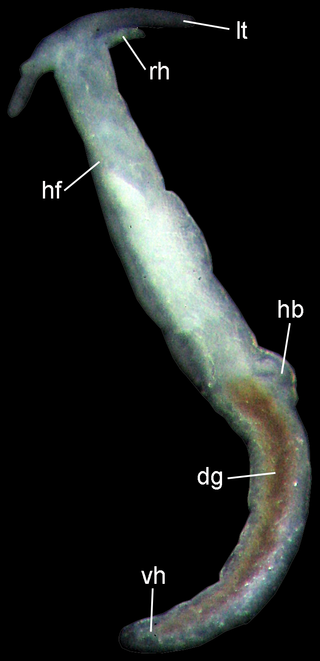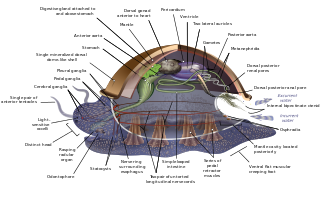Articles related to anatomy include:

The third ventricle is one of the four connected ventricles of the ventricular system within the mammalian brain. It is a slit-like cavity formed in the diencephalon between the two thalami, in the midline between the right and left lateral ventricles, and is filled with cerebrospinal fluid (CSF).

The tusk shells or tooth shells, technically the Scaphopoda, are members of a class of shelled marine mollusc with worldwide distribution, and are the only class of exclusively infaunal marine molluscs. Shells of species within this class range from about 0.5 to 18 cm in length. Members of the order Dentaliida tend to be larger than those of the order Gadilida.

The dorsal root of spinal nerve is one of two "roots" which emerge from the spinal cord. It emerges directly from the spinal cord, and travels to the dorsal root ganglion. Nerve fibres with the ventral root then combine to form a spinal nerve. The dorsal root transmits sensory information, forming the afferent sensory root of a spinal nerve.

Zonitoides arboreus, commonly known as the quick gloss snail, is a species of small air-breathing land snail, a terrestrial pulmonate gastropod mollusk in the family Gastrodontidae.

Fiona pinnata, common name Fiona, is a species of small pelagic nudibranch, a marine gastropod mollusk in the superfamily Fionoidea. This nudibranch species lives worldwide on floating objects on seas, and feeds mainly on barnacles, specifically goose barnacles in the genus Lepas.

The following outline is provided as an overview of and topical guide to human anatomy:

The nervous system of gastropods consists of a series of paired ganglia connected by major nerve cords, and a number of smaller branching nerves. It is sometimes called ganglionic.

Pseudunela cornuta is a species of minute sea slug, an acochlidian, a shell-less marine and temporarily brackish gastropod mollusk in the family Pseudunelidae. Adults are about 3 mm long and live in the spaces between sand grains.
Aiteng ater is a species of sea slug, a marine gastropod mollusc in the family Aitengidae. The specific name ater is from the Latin language and means black, in reference to the appearance of the slug on the mud.
Paraganitus ellynnae is a species of sea slug, an acochlidian, a shell-less marine gastropod mollusc in the family Microhedylidae.

This article describes anatomical terminology that is used to describe the central and peripheral nervous systems - including the brain, brainstem, spinal cord, and nerves.

Pseudunela viatoris is a species of sea slug, an acochlidian, a shell-less marine gastropod mollusk in the family Pseudunelidae.
Bathyacmaea nipponica is a species of very small, deep-sea limpet, a marine gastropod mollusk in the family Pectinodontidae.

The following Diagram is provided as an overview of and topical guide to the human nervous system:
Plocamopherus maculapodium is a species of sea slug, a nudibranch, a shell-less marine gastropod mollusk in the family Polyceridae.
Plocamopherus pecoso is a species of sea slug, a nudibranch, a shell-less marine gastropod mollusk in the family Polyceridae.

Berghia stephanieae is a species of sea slug, an aeolid nudibranch. It is a marine gastropod mollusc in the family Aeolidiidae. It was previously known as Aeolidiella stephanieae.

A circumesophageal or circumpharyngeal nerve ring is an arrangement of nerve ganglia around the esophagus/ pharynx of an animal. It is a common feature of nematodes, molluscs, and many other invertebrate animals, though it is absent in all vertebrate animals and is not structurally possible in simpler ones such as water bears.













